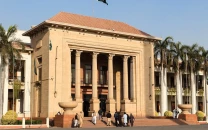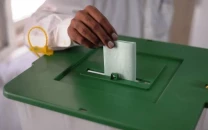In foggy weather, electricity fails to find a way to consumers
State-owned entities fail to maintain grid, keep pace with surging demand.

The electricity shortfall is currently hovering around the 5,000MW range. STOCK PHOTO
“We have been facing this issue since Monday morning. The lines tripped due to fog but electricity was restored by mid-day,” said Masood Ahmad, a National Power Control Center (NPCC) consultant, while talking to The Express Tribune.

Over the last two days, electricity consumers in Punjab have been facing unscheduled blackouts due to the tripping of those transmission lines, said a water and power ministry official. The transmission lines tripped near Guddu, which caused the South-to-North supply of electricity to be interrupted. In winter, when hydroelectric power production in the north of the country is lower, the overall direction of flow of electricity is from thermal power plants based mostly in Sindh and southern Punjab.
While about half of power generation in Pakistan is owned by privately-owned companies, almost the entirety of the transmission grid is owned by the government. State-owned companies that manage the grid have gotten so poor at maintaining the infrastructure in their care that tripping in main transmission lines in the south has now become routine. This adds frequent and sudden shortfalls to the system since the NPCC has to shut down some transmission lines to keep the National Grid frequency level above 50 megahertz in order to avoid another national blackout.
Bureaucracy can sometimes add to the delays. “We have to prepare and send an inquiry report before we restore the electricity each time the main transmission line trips,” said Ahmad.
Power shortages in Pakistan appear to have gotten worse in recent days as the government shut down natural gas supply to thermal power plants in order to supply the captive power generation units of the politically powerful textile industry.
Given the annual canal closures in winter, water flow in the river system and therefore hydroelectric power production is also down. Water flow at Tarbela Dam as of January 5 is 12,000 cubic feet per second (cusecs), and at 8,000 cusecs at Mangla Dam. On December 24, prior to the canal closures, the outflow was 26,000 cusecs and 40,000 cusecs respectively. As a result, hydroelectric power generation is down to an average of 966 MW, from its summer peak of 6,000 MW.
“Before the canal closure, we were getting more than 3,000 MW electricity which has now dropped to this level”, Ahmad added.
Independent Power Plants in the south that were using gas as fuel are now generating electricity through diesel. These includes SAIF, Sapphire, Orient and others. Meanwhile, the textile sector is getting six hours of gas every day, or 25% of their entire quota, said the water and power ministry official.
Yet despite the fact that the state-owned Sui Northern Gas Pipelines is not supplying gas to IPPs, there is still a shortfall of around 1,600 million cubic feet per day (mmcfd) out of total demand of 3,000 mmcfd in the SNGP system. Gas production in Pakistan is projected to have peaked last year and is set to decline, according to an analysis conducted by the petroleum ministry in 2011.
As a result, the electricity shortfall is currently hovering around the 5,000MW range. Each year around 800,000 new electricity connections are adding around 1,200MW of additional demand in the system, said the ministry official. “Our generation cannot keep pace with the demand at this stage, which is increasing the shortfall every year. In addition, the dilapidated transmission system is causing line losses of around 25%. It is expected the things to get worse in coming years if no serious efforts are made to rehabilitate the transmission system,” the official added.
Published in The Express Tribune, January 7th, 2015.
Like Business on Facebook, follow @TribuneBiz on Twitter to stay informed and join in the conversation.



















COMMENTS
Comments are moderated and generally will be posted if they are on-topic and not abusive.
For more information, please see our Comments FAQ